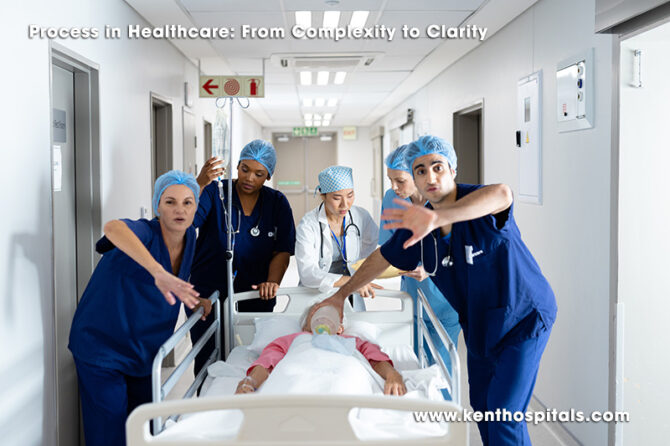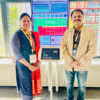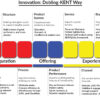
Healthcare is most likely one of the most intricate sectors—where people’s lives, advanced innovation, and organizational vision come together. In contrast to other sectors, healthcare is incapable of focusing merely on revenue generation; it is also compelled to balance clinical dominance, moral accountability, and sustainability. It is neither a single strategy but an overall framework.
The 5 Ps to Successful Healthcare—People, Process, Paraphernalia, Place, and Policies—all together constitute patient outcomes, organizational reputation, and fiscal sustainability. Of these 5 Ps, Process has an unusual talent for transforming complexity into clarity.
Procedures for healthcare delivery are frequently maze-like, from planning for treatment to diagnostic evaluation to follow-through care to insurance authorizations. For patients and families, that maze is tiring. A healthcare provider’s greatest strength is standardizing, simplifying, and humanizing care delivery.
Indian Example: Aravind Eye Care’s Streamlined Cataract Workflow
India’s most impressive demonstration of process excellence is probably the Aravind Eye Care System. Cataract surgery, most frequently performed surgery in the world, had been accompanied by extensive waiting lists and high costs. Aravind transformed that by instituting an assembly-line method of care—patients move through clearly defined stages from screening to counselling to surgery to follow-up with non-doctor staff performing standardized steps.
Process innovation lowered costs to lowest-in-the-world levels for surgery but also made Aravind a globe case study in doing more with less without a reduction in quality. In demonstration, scale results from clarity of process most especially where resources coincidentally are limited.
International Example: Mayo Clinic’s Care Coordination
Process clarity is exemplified in America by Mayo Clinic’s team-based practice. Instead of individual consultations with different specialists for a patient to see, Mayo organizes consultations so that cardiologists, endocrinologists, radiologists, and surgeons confer together face to face. Patients receive coordinated advice to prevent confusion and repeated investigations.
It is a very efficient but also patient-centered—illustrating how process clarity serves to reduce patient anxiety and build confidence—system. As an international standard, it illustrates how multidisciplinary collaboration can be integrated into everyday workflows.
Digital Transformation as a Process Catalyst
Technology is revolutionizing medical procedures throughout the world. In India, eSanjeevani, the national telemedicine service, has eradicated rural–urban inequalities by managing millions of consultations over a remote platform. It has optimized access to tertiary hospitals for patients from underserved regions while reducing congestion within tertiary hospitals.
Globally, Estonia has been a pioneer in digital health. Estonia’s national e-Health platform enables secure access by authorized providers to all citizens’ health record, prescriptions, and diagnosis history. It eliminates duplicates, places data ownership with the patient, and facilitates a seamless continuum of care.
Both scenarios reveal how information health tools can be an auxiliary support structure for clarity—facilitating an effective, transparent, and universally accessible process for healthcare.
Business Learning: Lean Thinking in Healthcare
Following industry principles, Lean Six Sigma and Kaizen have gained increasing success within health care. They work to eliminate waste, decrease variability, and continually improve process.
Fortis Healthcare in India applied Lean techniques to reduce wait lines for emergency departments and streamlined admissions. With journey-mapping for patients, they eliminated bottlenecks and expedited turn-around for critical care.
In Wisconsin, ThedaCare implemented principles of Lean to redesign their patient flows to reduce hospital-acquired infections significantly and accelerate discharge process.
Central learning is therefore one of standardizing procedures where possible but customization to individual patient needs. Patients want efficiency but individuality too, and organizations who achieve a successful blend create long-term confidence.
Challenges in Process Optimization
Even with success stories, some barriers remain:
Fragmentation of Systems: Smaller hospitals such as Indian hospitals have non-integrated systems for referral and maintaining records.
Change Resistance: Clinicians also resist standardized protocols because they think they will take away clinical autonomy.
Infrastructure Gaps: Infrastructural transformations entail investments that some institutions cannot finance.
But these issues also open innovation possibilities. AI-based clinical decision support, predictive analytics to enable patient triage, and robotic process automation of billing and claim processing are beginning to revolutionize process work everywhere. Apollo Hospitals, for instance, has deployed AI-based stroke pathways to accelerate treatment and diagnosis—process innovation that helps save lives.
Final thoughts
At its core, healthcare is clinical excellence but also about process clarity that a patient is subjected to. It could be Aravind Eye Care de-mystifying cataract surgery in India, Mayo Clinic aligning multidisciplinary care in the United States, eSanjeevani democratizing digital consultations throughout India, or Estonia building a national e-health infrastructure, but the lesson is one: process clarity fortifies both providers and patients.
5 Ps framework with Process at its core is a lens for sustainable development for the health sector. Embracing lean thinking, digital integration, and person-focused workflow enables health organizations to turn complexity into clarity such that systems function on behalf of people, not the other way around. As Steve Jobs famously declared, “Simple can be harder than complex; you have to work hard to get your thinking clean to make it simple. But it’s worth it in the end because once you get there, you can move mountains.” For healthcare, simplification is more than merely moving mountains—it is about saving lives.
Dr. Prahlada N.B
MBBS (JJMMC), MS (PGIMER, Chandigarh).
MBA in Healthcare & Hospital Management (BITS, Pilani),
Postgraduate Certificate in Technology Leadership and Innovation (MIT, USA)
Executive Programme in Strategic Management (IIM, Lucknow)
Senior Management Programme in Healthcare Management (IIM, Kozhikode)
Advanced Certificate in AI for Digital Health and Imaging Program (IISc, Bengaluru).
Senior Professor and former Head,
Department of ENT-Head & Neck Surgery, Skull Base Surgery, Cochlear Implant Surgery.
Basaveshwara Medical College & Hospital, Chitradurga, Karnataka, India.
My Vision: I don’t want to be a genius. I want to be a person with a bundle of experience.
My Mission: Help others achieve their life’s objectives in my presence or absence!
My Values: Creating value for others.
Leave a reply
















Dear Dr. Prahlada N.B Sir,
Your insights into the sustainability of hospital care resonate deeply. To achieve true sustainability, we must strive to break down *complexity* into *simplicity*, ensuring that healthcare delivery is both efficient and accessible. This requires a multifaceted approach:
1. *Simplicity in Processes*: Streamlining workflows and reducing unnecessary complications can enhance patient care and operational efficiency.
2. *Integrity with AI*: Leveraging artificial intelligence with transparency and ethical considerations can improve diagnostic accuracy and treatment plans, ultimately benefiting patient outcomes.
3. *Incorporating Latest Advancements*: Staying abreast of the latest developments in medical science ensures that patients receive cutting-edge care, fostering trust and satisfaction.
4. *Clarity in Communication*: Clear, empathetic communication between healthcare providers and patients is crucial for understanding and meeting patient needs, thereby enhancing satisfaction and trust.
5. *Waiting Time Reduction*:
– *Appointment Scheduling Systems*: Implementing advanced scheduling can minimize wait times and optimize patient flow.
– *Real-Time Updates*: Keeping patients informed about wait times and appointment statuses can improve their experience.
– *Efficient Triage*: Prioritizing patients based on urgency ensures timely care for those in need.
– *Staff Training*: Equipping staff with time management skills can further reduce delays.
By focusing on these elements—simplicity, integrity with AI, latest advancements, clarity in communication, and reduced waiting times—we can create a healthcare environment that is not only sustainable but also patient-centered and effective.
*Thank you for your thoughtful leadership and vision, sir.*
Reply